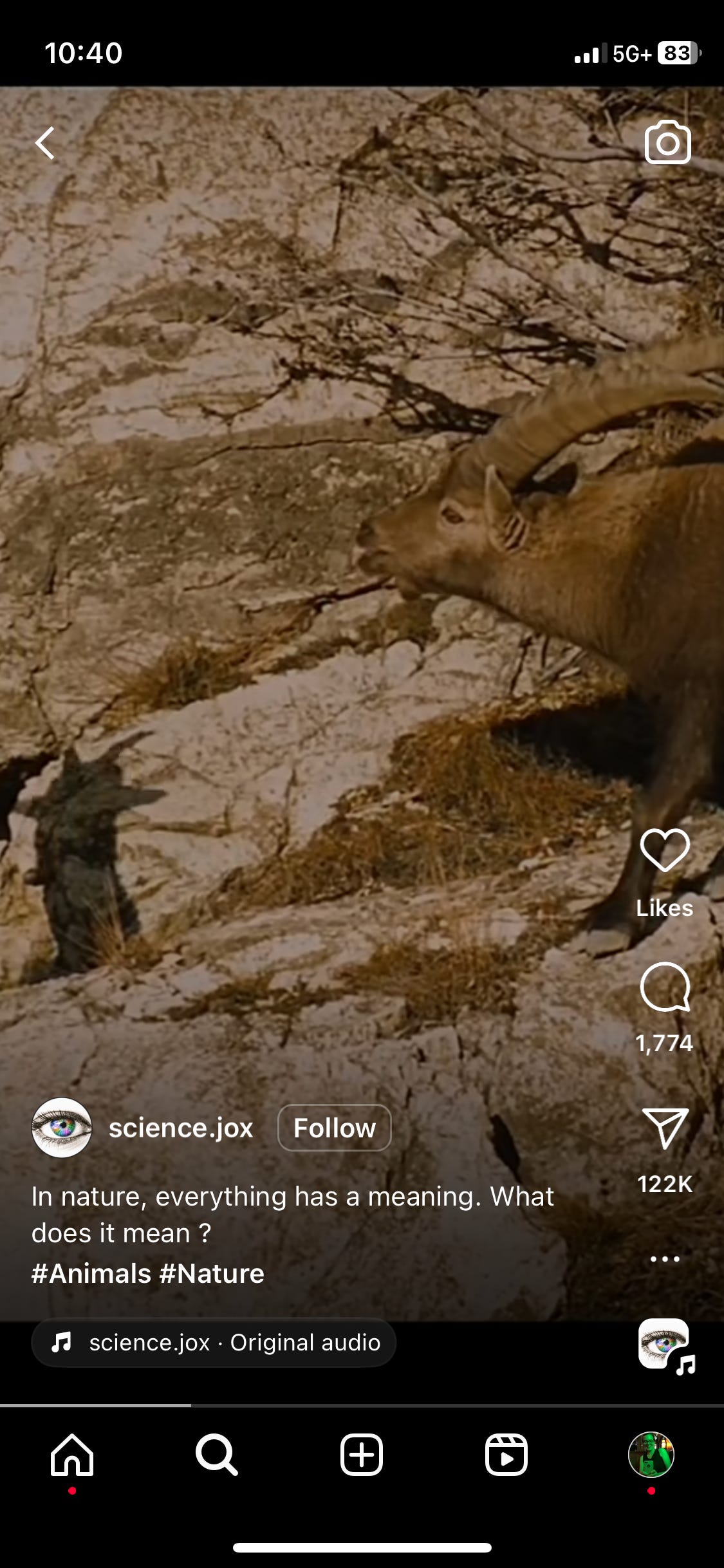Why Look at Instagram Reels?
Somewhere on my Instagram feed, I briefly scroll past, and then return to, a video of a mountain goat with large horns, or perhaps an ibex. It is not specified, and for the purposes of the video, it does not seem to matter. The goat is sticking out its tongue at a smaller goat with much smaller horns, presumably a female, and moving its tongue up and down in a way that would be anatomically impossible for a human. The female is backing away and dipping her head in response to his repeated advances. The caption reads, “In nature, everything has meaning. What does it mean? #Animals #Nature.”
I hesitated on this particular video because I found this caption, like so many similar Instagram captions, enigmatic in its laziness. It gives no direct information, no context. There is no note of what type of animal this is, or where the video came from. It was more than likely lifted from another account or video, rather than generated by the account itself. And it does not answer its own question about what the goat’s tongue flapping behavior “means.” At first, I was disappointed to discover that the commenters’ interpretations all related to oral sex. But then I Googled the true meaning of the behavior and discovered it is, in fact, a tool of courtship.
But I was not really meant to pause or digest this goat video — only to let the fragment coast past my vision, one of many. Before and after it were innumerable other videos of animals, people, people and animals. A gang of baboons intimidating a woman on a highway. A squirrel defending the dead body of another squirrel from the attacks of a crow, overlaid with the message “true love never dies” and a heartbreak emoji.
These aren’t exactly memes but material for metaphor. Not raw material but prefabricated material, already anthropomorphized for ease of applying it to human romantic situations. Each of these clips of animal life may be of use to us, or not, depending on how easily it matches an experience or feeling. The metaphorical effect is not intended to blow me away or to make me cry, or even laugh. Instead, it serves a regulatory function of restoring me to equilibrium, a microdose of recognition and wonder.
Instagram reels provoke the wonder at a small interaction between animals without the discomfiting reality of the natural world that one might have to confront even in a longer format like a nature documentary, not to mention the actual practice of observing and confronting wild animals in their habitats. Animals themselves are increasingly distant and unapproachable.
Scrolling more, I found a video clip of orcas (it’s not immediately clear if it’s a single orca from different cameras, or many orcas from the same camera) bumping dolphins into the air with their noses so that the dolphins twisted like fish. The clip does not convey the violence and terror of the natural world, preferring instead to invite the viewer to participate in the sport. As a viewer, you are expected to identify with the orca, not the dolphin. If you were really there, at boat level, this would be a terrifying thing to witness. Instead, it is the containment of unmanageable life inside a deadening format — containment, or domestication. Who even needs zoos, when we can imprison animals
The practice of making, processing, and looking at images is a central part of our lives, but a part that has also become strangely devoid of meaning. (I am trying to use “strange” like the Iliad uses “strange.”) People posting Instagram reels have kicked up their feet and given up on the work of producing meaning.
I recently have been watching short Instagram videos posted by woodworking masters. It is incredible to watch them make their own woodworking tools. (Making something out of nothing, like the Joseph story.) Why do these videos make me feel like I could do something I absolutely could not do? I feel the power pour into me, the thin power of knowledge without experience.




